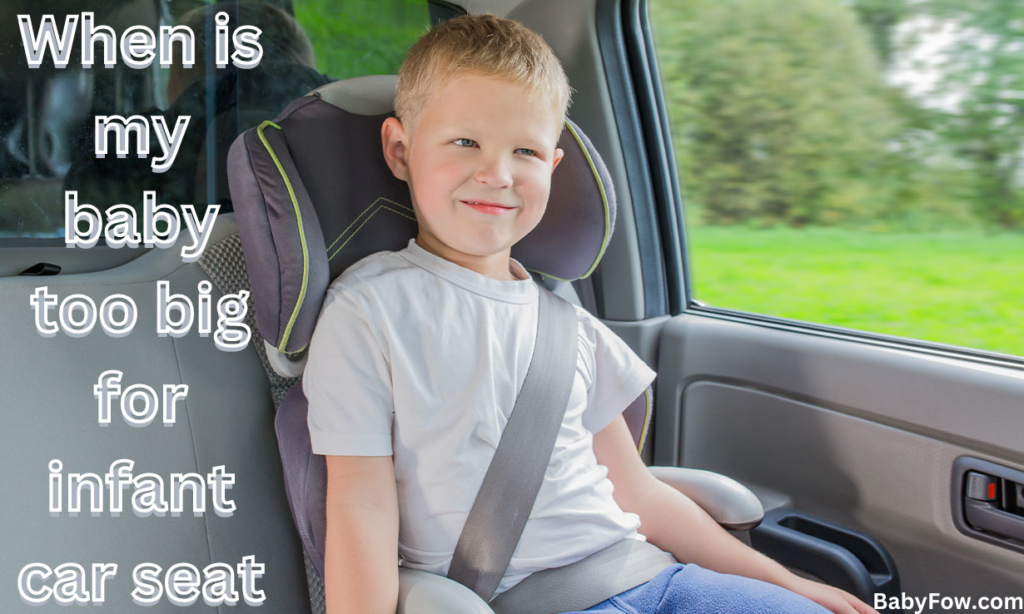When is My Baby Too Big for an Infant Car Seat?
Ensuring your baby’s safety while traveling is paramount, and one of the key aspects is knowing when your baby has outgrown their infant car seat. Transitioning to the appropriate car seat at the right time is essential for your child’s safety and comfort. This article explores the signs that indicate your baby is too big for an infant car seat, the steps to take next, and helpful tips for a smooth transition.
Understanding Infant Car Seats
Infant car seats are designed for the youngest passengers, providing a secure and cozy environment for your baby. These seats are typically used in a rear-facing position, which is the safest orientation for infants. Most infant car seats come with a detachable base that stays in the car, allowing parents to easily carry the seat with the baby in it.
Key Features of Infant Car Seats
- Rear-Facing Orientation: Protects the baby’s head, neck, and spine in the event of a collision.
- Portability: The seat can be detached from the base and used as a carrier.
- Compatibility with Strollers: Many infant car seats can be attached to compatible strollers, forming a convenient travel system.
| Feature | Description |
|---|---|
| Rear-Facing Orientation | Protects the baby’s head, neck, and spine in the event of a collision. |
| Portability | The seat can be detached from the base and used as a carrier. |
| Stroller Compatibility | Can be attached to compatible strollers, forming a convenient travel system. |
When is Your Baby Too Big for an Infant Car Seat?
Babies grow at different rates, so there isn’t a one-size-fits-all answer to when you should switch to a convertible car seat. However, there are general guidelines based on weight, height, and head position that can help you determine when it’s time to make the transition.
Weight Limits
Most infant car seats have a weight limit ranging from 22 to 35 pounds. It’s important to check the manufacturer’s specifications for your particular car seat. If your baby exceeds this weight limit, it’s time to move on to a convertible car seat【11†source】【12†source】.
Height Limits
Height limits for infant car seats typically range from 26 to 36 inches. A key indicator that your baby has outgrown the seat is when their head is less than one inch from the top of the seat. This ensures that in the event of a crash, their head is properly protected【11†source】【12†source】.
Head Position
If your baby’s head is less than one inch from the top of the car seat shell, they have outgrown the seat. Ensuring there’s enough head clearance is crucial for their safety【11†source】.

| Criteria | Typical Limits | Indicators |
|---|---|---|
| Weight | 22 to 35 pounds | Baby exceeds the weight limit set by the car seat manufacturer. |
| Height | 26 to 36 inches | Baby’s head is less than one inch from the top of the seat. |
| Head Position | Less than one inch | Baby’s head is less than one inch from the top of the car seat shell when buckled in. |
The Next Step: Choosing a Convertible Car Seat
Once your baby has outgrown their infant car seat, the next step is to transition to a convertible car seat. These seats are designed to accommodate a growing child and can be used in both rear-facing and forward-facing positions.
Benefits of Convertible Car Seats
- Extended Rear-Facing Use: Convertible seats typically have higher weight and height limits for rear-facing use, allowing your child to stay in the safer rear-facing position for longer.
- Long-Term Use: Convertible car seats can be used from infancy through toddlerhood and beyond, often up to 65 pounds or more in the forward-facing position【10†source】【12†source】.
| Type | Usage | Benefits |
|---|---|---|
| Convertible Car Seat | Rear-facing for infancy, forward-facing for toddlers | Higher weight and height limits for rear-facing, long-term use up to 65 pounds or more. |
Installation Tips for Convertible Car Seats
Proper installation of your car seat is crucial for ensuring your child’s safety. Here are some tips to help you get it right:
Rear-Facing Installation
- Level the Seat: Ensure the car seat is installed at the correct angle to protect your baby’s head and spine.
- Secure the Base: Use either the seat belt or LATCH system to secure the car seat base tightly. The seat should not move more than an inch side-to-side or front-to-back when tested.
- Check the Harness: Make sure the harness straps are snug and the chest clip is at armpit level to prevent slipping【10†source】.
Common Installation Errors to Avoid
- Loose Installation: Always check that the car seat is tightly secured.
- Incorrect Angle: Use the angle indicator on the car seat to ensure it’s positioned correctly.
- Misplaced Harness: The harness should fit snugly without twisting, and the chest clip should be at armpit level【10†source】.
| Installation Step | Description |
|---|---|
| Level the Seat | Ensure the car seat is installed at the correct angle. |
| Secure the Base | Use seat belt or LATCH system to secure the car seat base tightly. |
| Check the Harness | Ensure harness straps are snug and chest clip is at armpit level. |
| Common Errors to Avoid | Loose installation, incorrect angle, misplaced harness. |
Safety Considerations
Keeping your baby safe during car rides involves more than just installing the car seat correctly. Here are some additional safety tips:
Harness Safety
Ensure that the harness straps are snug and not twisted. The chest clip should be positioned at armpit level to keep the straps in place during a crash【12†source】.
Proper Positioning
For rear-facing seats, maintain an angle of 40-45 degrees to support your baby’s head and neck. Babies should remain rear-facing until they reach the maximum height or weight limit for their car seat, which can often be until age two or older【12†source】.
Car Seat Expiry
Car seats have an expiration date, typically between 6 to 10 years from the manufacturing date. Check the label on your car seat to ensure it hasn’t expired, as materials can degrade over time, affecting the seat’s safety【11†source】.
| Safety Tip | Description |
|---|---|
| Harness Safety | Ensure harness straps are snug and not twisted, chest clip at armpit level. |
| Proper Positioning | Maintain an angle of 40-45 degrees for rear-facing seats. |
| Car Seat Expiry | Check the expiration date on your car seat to ensure it’s still safe to use. |
FAQs and Common Misconceptions
Is My Baby Too Large for Rear-Facing?
It’s common to worry that your baby may outgrow the rear-facing position. However, most convertible car seats allow children to remain rear-facing until they are 40-50 pounds or about 49 inches tall. Keeping your child rear-facing for as long as possible is recommended for maximum safety【10†source】【12†source】.
Can I Reuse an Infant Car Seat for a Second Child?
As long as the car seat has not expired and has not been involved in a car accident, it can generally be reused. Always check for recalls and ensure all parts are in good condition【12†source】.
| FAQ | Answer |
|---|---|
| Is My Baby Too Large for Rear-Facing? | Most convertible car seats allow rear-facing until 40-50 pounds or about 49 inches. |
| Can I Reuse an Infant Car Seat? | Yes, if the seat has not expired and has not been in a car accident. |
Tips for a Smooth Transition
Transitioning to a convertible car seat can be a big change for both you and your baby. Here are some tips to make the switch smoother:
Gradual Introduction
Introduce the new car seat gradually. Allow your baby to sit in it at home or during short trips before using it for longer journeys. This can help them get accustomed to the new seat.
Comfort and Familiarity
Place familiar items, such as your baby’s favorite blanket or toy, in the new car seat. This can provide comfort and make the new seat feel more familiar.
Consistency is Key
Once you switch to the convertible car seat, try to use it consistently. Frequent changes between different seats can confuse your baby and make the transition harder.
Safety First
Even during the transition period, ensure that the new car seat is installed correctly and that your baby is securely fastened. Safety should always be the top priority.
READ MORE :
What are the 5 stages of child development?
Tips for Traveling with Babies
Traveling with a baby involves careful planning and preparation. Here are some additional tips to ensure a safe and comfortable journey for your little one:
Plan Ahead
Ensure you have all necessary items, including diapers, wipes, extra clothes, and snacks. Having everything within easy reach can make the trip smoother.
Frequent Breaks
If you’re on a long trip, take frequent breaks to allow your baby to stretch and move around. This can help prevent fussiness and discomfort.
Stay Calm
Traveling with a baby can be stressful, but staying calm and patient can make a big difference. Your baby will pick up on your cues, so maintaining# When is My Baby Too Big for an Infant Car Seat?
Ensuring your baby’s safety while traveling is paramount, and one of the key aspects is knowing when your baby has outgrown their infant car seat. Transitioning to the appropriate car seat at the right time is essential for your child’s safety and comfort. This article explores the signs that indicate your baby is too big for an infant car seat, the steps to take next, and helpful tips for a smooth transition.









Pingback: Baby Food Recipes 9 To 12 Months. - Babyfow.com